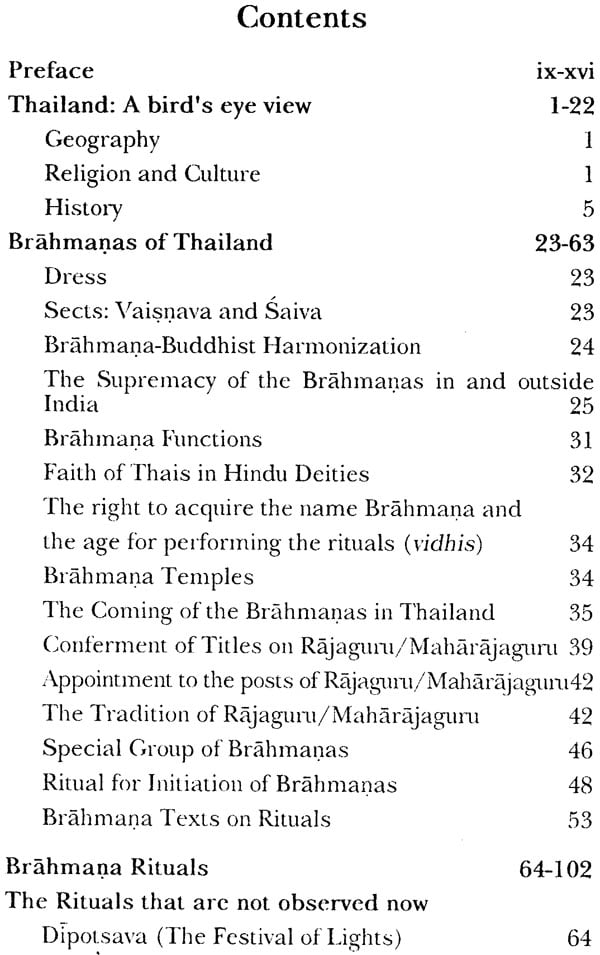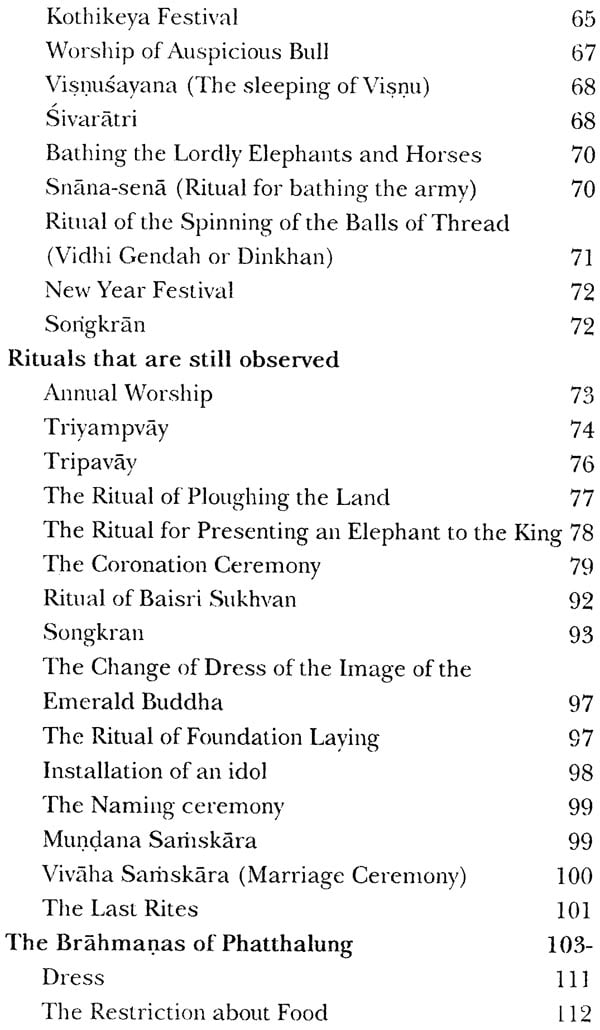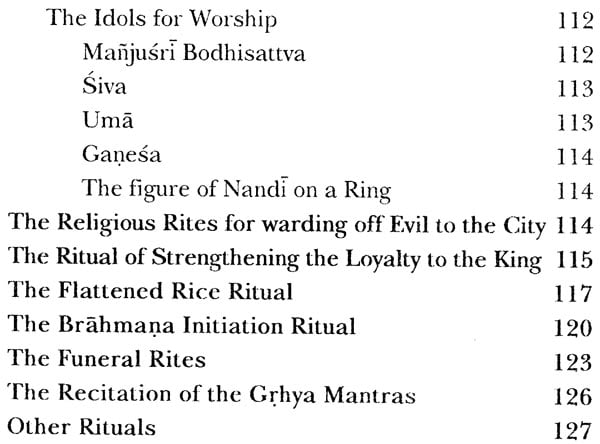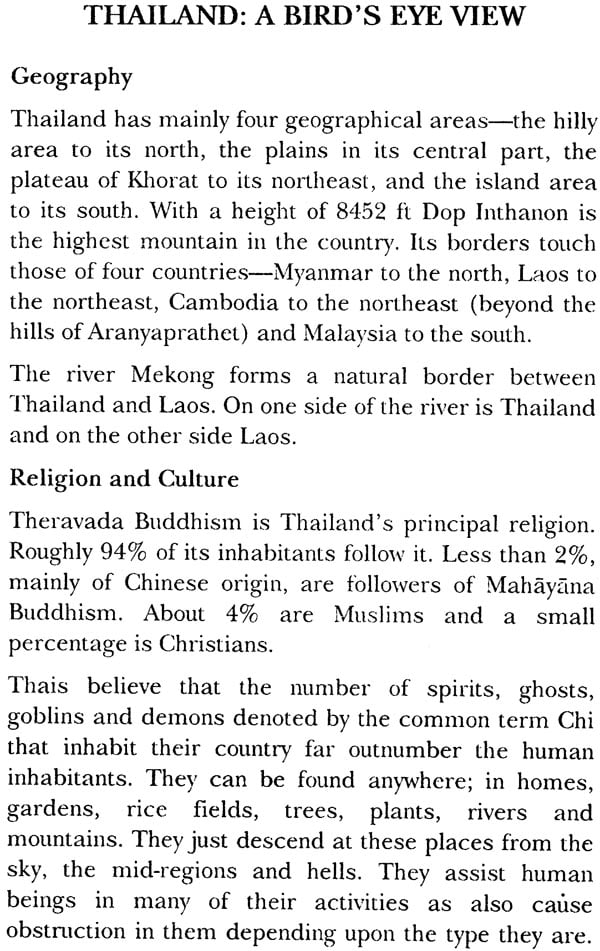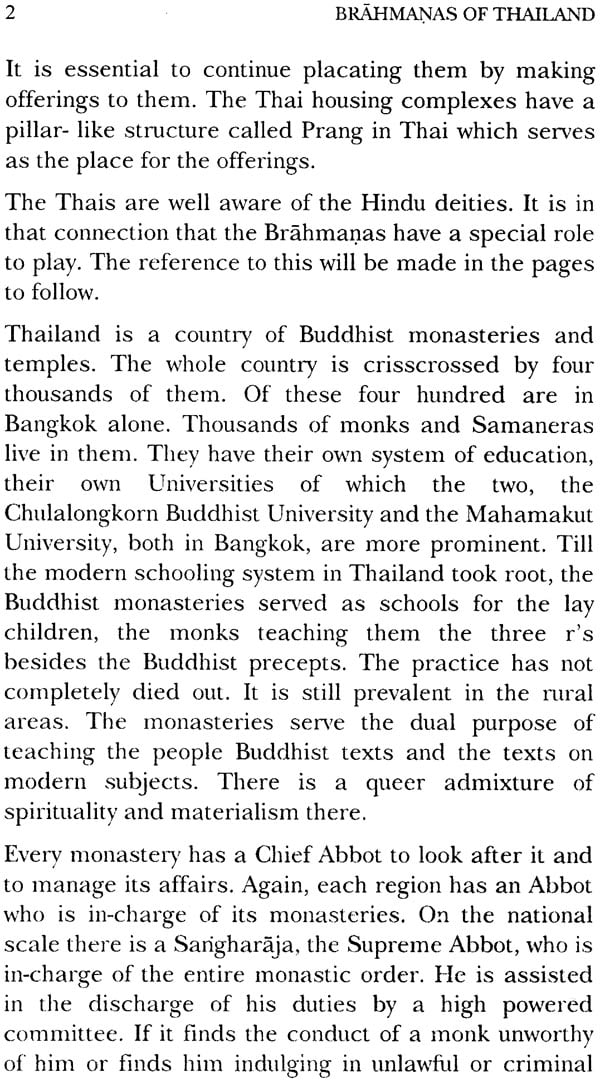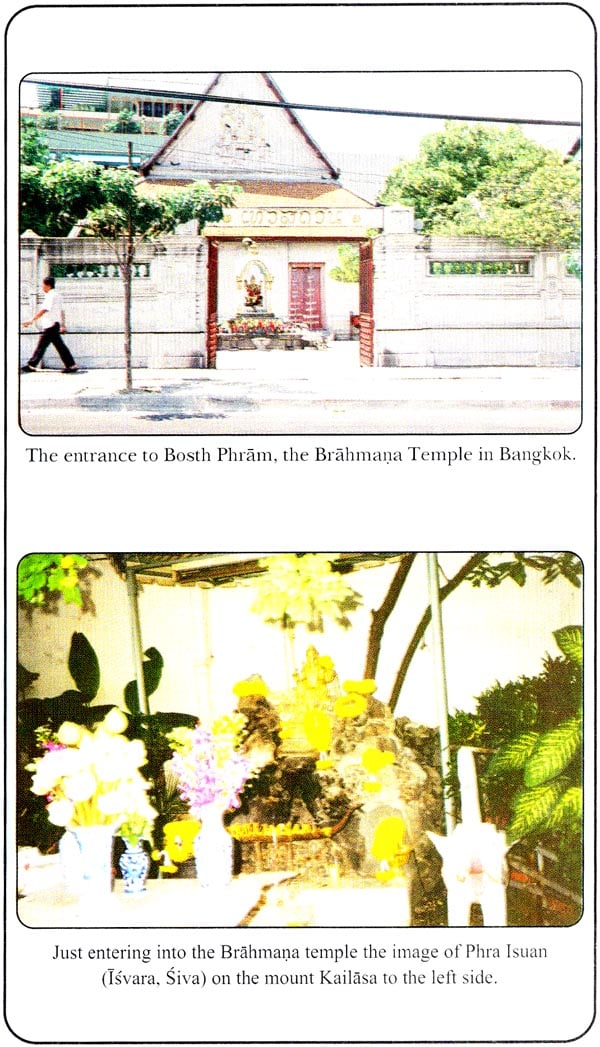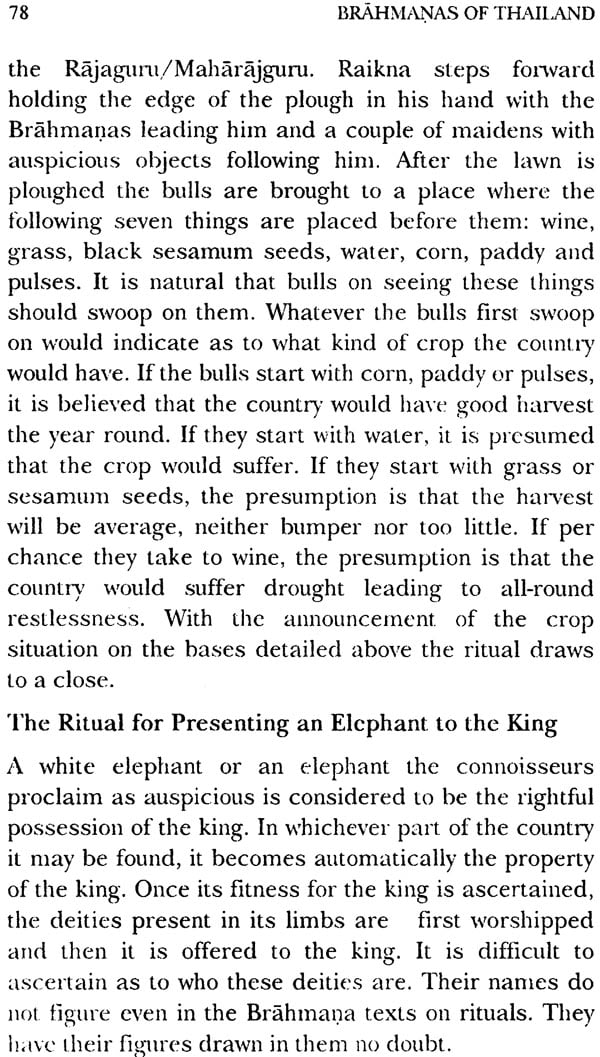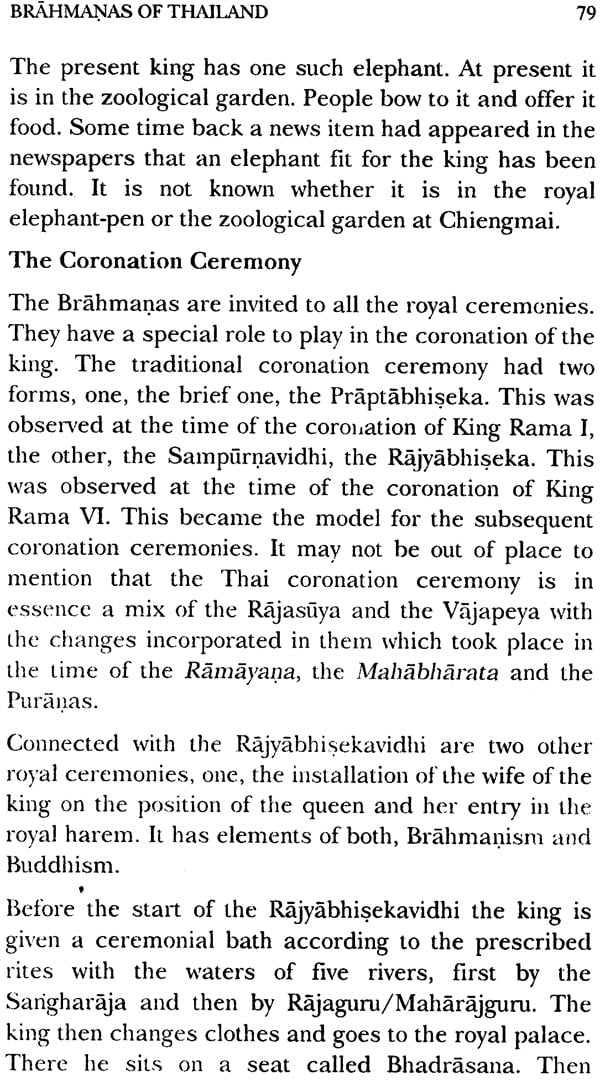
Brahmanas of Thailand
Book Specification
| Item Code: | NAS011 |
| Author: | Satya Vrat Shastri |
| Publisher: | Parimal Publication Pvt. Ltd. |
| Language: | English |
| Edition: | 2015 |
| ISBN: | 9788171105076 |
| Pages: | 144 |
| Cover: | HARDCOVER |
| Other Details | 8.50 X 5.50 inch |
| Weight | 360 gm |
Book Description
There is a community in Thailand which calls itself Brahmana. It is a tribute to its vitality that it has maintained its separate identity in the midst of an overwhelmingly Buddhist society. It is different from the other inhabitants of the country in dress, customs, manners, traditions and lifestyle. It has its own temples, its own system of worship, its own festivals, its own rituals and its own sacred texts. It has a long tradition of its Rajagurus and Maharajagurus. It has its own system of initiation and a well- defined process of appointment to the post of Rajaguru/Maharajguru. It has a vital role to play in ceremonies that concern the monarchy like the coronation of the king, and the ceremonies like marriage that concern the common people.
The present work is the first attempt of its kind in presenting an authentic account of that community, its authenticity ensured by its being based on personal interviews with the present Maharajaguru spread over several weeks.
Born on 29" September 1930, Prof. Satya Vrat Shastri had his early education under his father, Prof. Charu Deva Shastri. He was consistently top rank holder up to Post- Graduation and won University Medals. After doing his Ph. D. at the Banaras Hindu University he joined the University of Delhi where during the forty years of his teaching career he held important positions of the Head of the Department of Sanskrit and Dean of the Faculty of Arts. He was also the Vice-Chancellor of Shri Jagannath Sanskrit University, Puri, Orissa. He is the first recipient of the Jnanpith Award in Sanskrit, 2009 and the Padma Bhushan Award, 2010.
He has the distinction of having been Visiting Professor in five Universities on three Continents. Among his many foreign students the most prominent is Her Royal Highness Maha Chakri Sirindhorn, the Princess of Thailand. He has attended and chaired a number of national and international conferences and seminars and delivered more than a hundred lectures in Universities and institutions of higher learning in Europe, North America, Southeast Asia and the Far East.
Both a creative writer and a literary critic, Prof. Satva Vrat Shastri has to his credit three Sanskrit Mahakavyas of about a thousand stanzas each, a Prabandhakavya, a Patrakavya (in two volumes), three Khandakavyas, the first ever diary in Sanskrit Dine Dine Yati Madtyajivitam and the first ever autobiography in Sanskrit Bhavitavyadnam Dvdrani Bhavanti Sarvatra. The well- acclaimed critical work, The Ramayana- A Linguistic Study which is the first ever linguistic appraisal of not only the Valmiki-Ramayana but of any extant Sanskrit work, Kalidasa Studies in two volumes, two studies on Thailand, Sanskrit and Indian Culture in Thailand and Thaidesa Ke Brahmana, Discovery of Sanskrit Treasures (in seven volumes), Sanskrit Studies- New Perspectives and Sanskrit Writings of European Scholars, Introducing Modern Sanskrit Works, Human Values- Definitions and Interpretations, more than a century and a half of research articles and Forewords to a hundred and thirty books are his contributions as a critic. He has enormous experience in translation work. He has translated A.A. Macdonell’s A Vedic Grammar for Students in Hindi, Sriramacaritabdhiratnam of Nityananda Shastri in English, a thousand Subhasitas, wise sayings, the Subhdsitasadhasri in Hindi and English, the Canakyaniti in Hindi and English. He is the subject matter of twenty theses for the degrees of M.Phill., Ph.D. and D.Litt. in Indian Universities.
He has promoted Sanskrit not only in India but also abroad. Among his many foreign students the most prominent is Her Royal Highness Mahachakri Sirindhorn, the Princess of Thailand. He has been instrumental in setting up the Sanskrit Study Centre at the Silpakorn University, Bangkok. The library of the Department of Oriental Languages of the said university is named after him. He is the recipient of ninety six Honours and Awards, national and international, including Padma Shri, Padma Bhushan, President of India Certificate of Honour, Thai Royal Decoration "The Most Admirable Order of Direk Gunabhorn", the Honour "Autorita Academische Italiano Straniere’", the Civil and Academic Authority for Foreigners from the Govt. of Italy, the Medallion of Honour from the Catholic University, Leuven, Belgium, the Golden Prize from CESMEO, the International Institute of Advanced Asian Studies, Torino, Italy and five Honorary Doctorates from Indian and Foreign Universities. In the Citation for the Honorary Doctorate at the Silpakorn University, Bangkok, he was described as "a living legend in the field of Sanskrit".
He is at present Chairman, Sanskrit Commission, Govt. of India.
Nestling in the heart of Southeast Asia, Thailand, which the Thais call in their language Prathet Thai, Sanskrit form Pradesa Thai or Thai Pradesa, is predominantly a Buddhist country. It is only in the provinces adjoining Malaysia that the Muslims predominate. In the rest of the country it is Buddhists who have an upper hand. There are as many as two lac and forty thousand Buddhist monks in the country. The number of Buddhist monasteries is four thousands of which four hundred are in Bangkok alone. The Hindu population in it is negligible. As of the Hindus as there are, are the ones who migrated from India during the past two centuries or so. That being the demographic position, the very words Blrahmanas of Thailand are sure to cause a bit of a surprise. Who were these Brahmanas, from where did they come (they wouldn't have been there originally because the Thais themselves are not said to be the original inhabitants; they are said to be of Chinese origin, having settled in days of yore in Siam— the country was known by that name originally, the name Thailand was given to it in1939). They are said to have been inhabitants of the Yunnan province of China from where they migrated in bygone ages settling first in the central part of the country and then spreading in other parts); when did they come, why did they come. It is natural for such questions to arise in one’s mind. The present volume is an attempt to answer all these questions. The Brahmanas of Thailand have their own temples, their own system of worship and their own texts of rituals. In spite of having been surrounded by the Buddhists they have maintained their separate identity. They have continued with their original system of dress, habits and manners. They did not allow themselves to be assimilated in the Buddhist society, though it was natural for them to feel its impact in some measure. They, for example, have to undergo initiation in Buddhism along with initiation in Brahmanism. So also is it Important to note that a mere birth in a Brahmana family does not entitle one to be called a Brahmana. For this he has to have initiation in Brahamanahood. It is only the Rajaguru or the Maharajguru who is authorised to admit a person in Brahmanahood. This initiation is the prerogative of the Rajaguru/Maharajaguru. As per tradition, the Brahmanas had come from India, alone, unaccompanied by women. It is only in Thailand that they married and begot children on their Thai wives. In spite of this intermingling of the two cultures, they kept their customs and traditions intact.
From the very beginning they enjoyed royal patronage. It was not only in Thailand but in other countries of Southeast Asia as well that the then ruling monarchs extended patronage to them.
Sasanaphram, Sasanabrahmana or Brahmanasasana, (that is the term for Hinduism in Thai) accords the status of Visnu to a king. He is accepted there as a deity—mahati devata hy esa narartipena tisthati, ‘he (the king) is a great deity in human form’ as Manu puts it. This kind of faith on account of the re-inforcement of their overlordship went well with the kings. The rituals of Brahmanas, their tantra (the magical and mystical formulae), mantra (the incantations) and yantra (the mystical or astronomical diagrams) differentiate them from others by supposedly infusing in them supernatural powers and impart to them divinity. This belief made the kings look up to Brahmanism and its followers with a measure of reverence. The Brahmana ritual for them was like an invincible armour which, they thought, would protect them from any kind of evil influences, bring success to all their schemes and lend them a divine glamour. For that reason they felt the need for Brahmana rituals despite their being followers of some other religion and that accounted for the need for them of the Brahmanas. Because of the royal patronage the common people also came to feel that the Brahmana ritual certainly is invested with some supernatural power. That is why they too have faith in the efficacy of their rituals. That also is the reason that in spite of the country being Buddhist for most part, the Brahmanas have their presence in it and the people in general view their rituals with respect.
The available information is too sketchy to allow us to determine precisely as to when the Brahmanas came to Thailand. This much, however, can be said that because Thailand was a part of the Cambodian empire during the eighth and the ninth centuries it was, as was natural, deeply influenced by the Cambodian religious traditions. It is possible that Brahamanism entered into Thailand through Cambodia where it was firmly rooted. There is another view according to which it came directly from India with the people who came to settle there.
The contact between India and Thailand is very old. Centuries back the Indian merchants sailed from the ports of Gopalpur in the east and Tamralipti in the south with ships laden with merchandise touching the ports at Chaya (Jaya) and Nakhon Si Thammarat (Nagara Sri Dharmaraja) where they would sell their ware and buy the merchandise from there which they brought back to their country for sale. There is a strong possibility that some Brahmanas would also have accompanied them to perform their rituals. Of them some might have come back to India while some might have stayed on. As of them as chose to stay on continued observing their religious practices. Under their influence some locals might also have started following those practices. They might also have started worshipping the Brahmana deities and would have developed faith in them and would have adopted their philosophy and beliefs. The saine could also be said about their dress code (the traditional dress of the Thai or the Siamese men is Dhoti worn in the same style as in India), their way of life (an example — their eating with fingers), the episodes from the Ramayana, the Mahabharata and the Puranas reproduced both in literature and arts, performing and visual. This paved the way for an overarching influence of the Indian culture on Thai society.
**Contents and Sample Pages**
